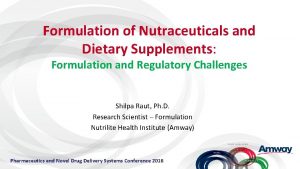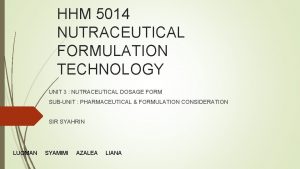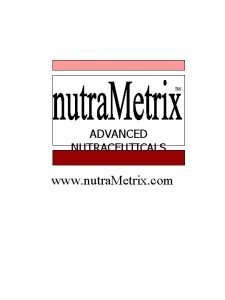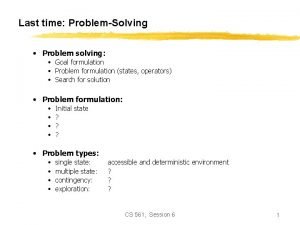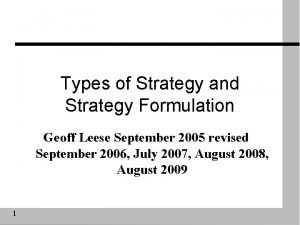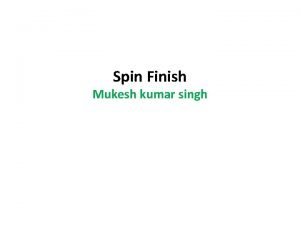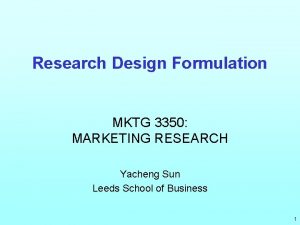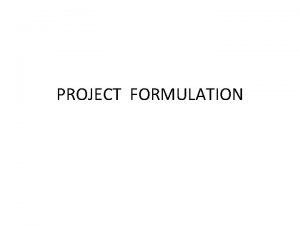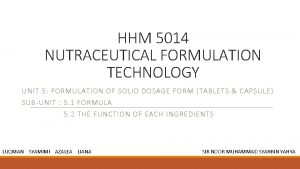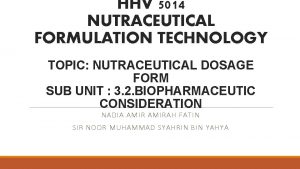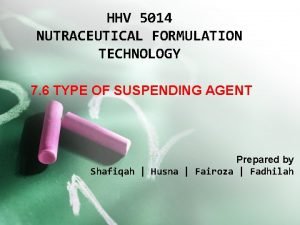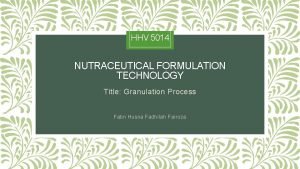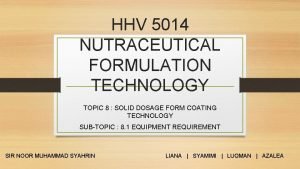HHM 5014 NUTRACEUTICAL FORMULATION TECHNOLOGY CHAPTER 5 FORMULATION









- Slides: 9

HHM 5014 NUTRACEUTICAL FORMULATION TECHNOLOGY CHAPTER 5 : FORMULATION OF SOLID DOSAGE FORM (TABLET AND CAPSULE ) 5. 6 : DRYING PROCESS AFIQ | SHAHMI | NINA

�Drying is a most important step in the formulation and development of pharmaceutical product. �It is important to keep the residual moisture low enough to prevent product deterioration and ensure free flowing properties. �The commonly used dryer includes Fluidized bed dryer, Vacuum tray dryer, Microwave dryer, Spray dryer, Freeze dryer, Turbo - tray dryer, Pan dryer.

A process of evaporating the liquid contained within aggregates produced by a wet granulation process to a predetermined moisture content Process: To reduce the moisture level of wet granules

�Two drying techniques based on different principles, fluid-bed and microwave-vacuum,

�Single machines utilized for both the wet granulation and drying process in one unit operation. �Use Fluid Bed Dryer (FBD) �It is a multiple step process performed in the same vessel to mix, granulate and dry the powders. �Combines wetting the powders to for granules and then, drying them in the same piece of equipment.

�The wet granulation stage is a central unit operation in the processing industry, being used, for example, in the food, fertilizer and pharmaceutical sectors. �One possible way of carrying out the drying of powders and granules is by convective hot air or under a flow of inert gas, combined with the application of microwaves. �Microwaves are not usually applied alone in the drying process, but are combined with conventional heating. �The use of vacuum in the microwave drying process could be of interest especially for thermo-labile products such as food and pharmaceutical powders and granules

�The granules produced in a traditional high-shear granulator and dried in a vacuum chamber had a lower level of porosity and higher bulk and tapped densities, due to the special characteristics of the drying process. �They retained their spherical form, in contrast to the granules dried using fluid-bed technology.

�The drying time for the combined microwave and hot air process was 45 minutes, from an initial moisture content of 42% to 3% d. b. � 4 hours for the convective hot air alone, for the same moisture range. �For the microwave assisted vacuum process the drying time was 20 minutes, from an initial moisture content of 25% to 2. 0% d. b.

�The vacuum assisted microwave drying showed good results as compared to the combined microwave and hot air drying process. Shorter drying times and lower product temperatures were observed.
 Dietary supplement formulation
Dietary supplement formulation Nutraceutical formulation
Nutraceutical formulation Nutra metrix
Nutra metrix Why problem formulation follow goal formulation
Why problem formulation follow goal formulation Role of hrm in strategy formulation
Role of hrm in strategy formulation Types of strategy formulation
Types of strategy formulation Spin finish oil formulation
Spin finish oil formulation Research design formulation
Research design formulation Project formulation definition
Project formulation definition Steps involved in portfolio management
Steps involved in portfolio management
